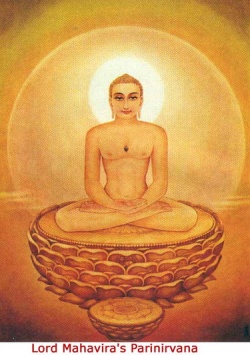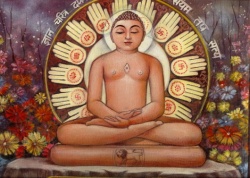Difference between revisions of "Tirthankara"
(Created page with "thumb|250px| In Jainism, a '''Tīrthaṅkara''' (Sanskrit: तीर्थंकर "ford-Maker", Tamil: கடவுள் Kaṭavuḷ) is a human bei...") |
m (1 revision imported: VTao import from old cont) |
||
| (3 intermediate revisions by one other user not shown) | |||
| Line 1: | Line 1: | ||
| − | [[File: | + | [[File:Nirvana457.jpg|thumb|250px|]] |
| − | In Jainism, a '''Tīrthaṅkara''' (Sanskrit: तीर्थंकर "ford-Maker", Tamil: கடவுள் Kaṭavuḷ) is a human being who helps in achieving liberation and enlightenment as an "Arihant" by destroying their soul-constraining (ghati) karmas, became a role-model and leader for those seeking spiritual guidance | + | In [[Jainism]], a '''[[Tīrthaṅkara]]''' ([[Sanskrit]]: [[तीर्थंकर]] "ford-Maker", {{Wiki|Tamil}}: [[கடவுள்]] [[Kaṭavuḷ]]) is a [[human being]] who helps in achieving [[liberation]] and [[enlightenment]] as an "[[Arihant]]" by destroying their soul-constraining ([[ghati]]) [[karmas]], became a role-model and leader for those seeking [[spiritual]] guidance. |
| − | + | {{Wiki|Tirthankaras}} revitalize [[Jain]] {{Wiki|Society}} by organization of fourfold [[Jain]] [[Order]] consisting of [[monks]], [[nuns]], [[laymen]] and [[laywomen]]. | |
| − | Jain scriptures define the term tirthankara as follows: the contrivance which help us to cross the great ocean of worldly life is called Tirtha and the person who makes that tirtha is known as tirthankara. | + | Not all [[souls]] become {{Wiki|Tīrthaṅkaras}}. |
| + | |||
| + | There are twenty-four {{Wiki|Tīrthaṅkaras}} in this [[time]] {{Wiki|era}} who revitalized the [[Jain]] [[Order]]. | ||
| + | |||
| + | [[Tirthankara]] is also said to mean “[[full moon]],” a {{Wiki|metaphorical}} reference to [[Kevala Jnana]], the [[spiritual state]] achieved by [[exalted]] and rare [[beings]]. | ||
| + | |||
| + | [[Keval Gnan]] is a [[state of permanent, perpetual, absolute knowledge of the Soul]]; it is the precursor to [[moksha]], [[final liberation from samsara]], the cycle of [[birth]] and [[death]]. | ||
| + | |||
| + | [[Jain]] [[scriptures]] define the term [[tirthankara]] as follows: the contrivance which help {{Wiki|us}} to cross the great ocean of [[worldly]] [[life]] is called [[Tirtha]] and the [[person]] who makes that [[tirtha]] is known as [[tirthankara]]. | ||
Overview | Overview | ||
| + | [[File:IMG8a.jpg|thumb|250px|]] | ||
| + | {{Wiki|Tīrthaṅkaras}} [[religious]] [[teaching]] [[form]] the basis for [[Jain]] canons. The inner [[knowledge]] of [[Tīrthaṅkara]] is [[perfect]] and [[identical]] in every [[respect]] and their teachings do not contradict one another. | ||
| + | |||
| + | However, the [[degree]] of [[elaboration]] varies according to the [[spiritual]] advancement and [[purity]] of the {{Wiki|society}} during their period of [[leadership]]. | ||
| + | |||
| + | The [[higher]] the [[spiritual]] advancement and [[purity]] of [[mind]] of the {{Wiki|society}}, the lower the [[elaboration]] required. | ||
| + | |||
| + | While {{Wiki|Tirthankaras}} are documented and revered by those of [[Jain]] [[faith]], their grace is said to be available to [[living beings]], regardless of [[religious]] orientation. | ||
| − | + | {{Wiki|Tirthankaras}} dwell exclusively within the [[realm]] of their [[Soul]], and are entirely free of [[kashayas]], inner [[passions]], and personal [[desires]]. | |
| − | + | As a result of this, [[unlimited]] [[siddhis]], [[spiritual]] [[powers]], are readily available to them – which they use exclusively for the [[spiritual]] elevation of [[living beings]]. Through their [[darshan]], [[divine]] [[vision]], and [[deshna]], [[divine]] [[speech]], they grant their [[own]] [[state]] of [[Keval Gnan]], and [[moksha]], final [[liberation]] to anyone seeking it sincerely. | |
| − | + | At the end of his [[human]] [[life-span]], a [[Tīrthaṅkara]] achieves [[siddha]] {{Wiki|status}}, ending the cycle of [[infinite]] [[births]] and [[deaths]]. | |
| − | + | [[Jainism]] postulates that [[time]] has no beginning or end. It moves like the [[wheel]] of a cart. {{Wiki|Jains}} believe that exactly twenty-four {{Wiki|Tīrthaṅkaras}} are born in each half-cycle of [[time]] in this part of the [[universe]]. The [[first Tīrthaṅkara]] is [[Rishabha]], who is credited for formulating and organising [[humans]] to [[live]] in a {{Wiki|society}} harmoniously. The 24th and last [[Tīrthaṅkara]] was [[Mahavira]] (599-527 BC). [[Digambara]] {{Wiki|Jains}} believe that [[Tīrthaṅkara]] were men, but [[Svetambara]] {{Wiki|Jains}} believe that the 19th [[Tīrthaṅkara]], [[Mallinath]], was a woman. | |
| − | + | Particular {{Wiki|Tīrthaṅkaras}} | |
| − | Particular Tīrthaṅkaras | ||
| − | Tīrthaṅkara images are usually seated with their legs crossed in front, the toes of one foot resting close upon the knee of the other, and the right hand lying over the left in the lap. | + | [[Tīrthaṅkara]] images are usually seated with their {{Wiki|legs}} crossed in front, the toes of one foot resting close upon the knee of the other, and the right hand {{Wiki|lying}} over the left in the lap. |
| − | In Jain tradition the Tīrthaṅkaras were royal in their final lives, and Jain traditions record details of their previous lives, usually as royalty. Their clan and families are also among those recorded in very early, or legendary, Hindu history. All but two of the Jains are ascribed to the Ikshvaku dynasty. Munisuvrata, the twentieth, and Neminatha, the twenty-second, were of the Harivamsa. Jain canons state that Rishabha, the first Tīrthaṅkara, founded the Ikshvaku. | + | In [[Jain]] [[tradition]] the {{Wiki|Tīrthaṅkaras}} were {{Wiki|royal}} in their final [[lives]], and [[Jain]] [[traditions]] record details of their previous [[lives]], usually as royalty. Their {{Wiki|clan}} and families are also among those recorded in very early, or legendary, [[Hindu]] {{Wiki|history}}. All but two of the {{Wiki|Jains}} are ascribed to the [[Ikshvaku]] {{Wiki|dynasty}}. [[Munisuvrata]], the twentieth, and [[Neminatha]], the twenty-second, were of the {{Wiki|Harivamsa}}. [[Jain]] canons [[state]] that [[Rishabha]], the first [[Tīrthaṅkara]], founded the [[Ikshvaku]]. |
| − | Twenty Tīrthaṅkaras achieved siddha status on Shikharji. Vasupujya attained nirvana at Champapuri in North Bengal; Neminatha on Girnar in Gujarat; and Mahavira, the last at Pawapuri, near modern Bihar's capital, Patna. | + | Twenty {{Wiki|Tīrthaṅkaras}} achieved [[siddha]] {{Wiki|status}} on [[Shikharji]]. [[Vasupujya]] [[attained]] [[nirvana]] at Champapuri in {{Wiki|North}} {{Wiki|Bengal}}; [[Neminatha]] on Girnar in {{Wiki|Gujarat}}; and [[Mahavira]], the last at Pawapuri, near {{Wiki|modern}} Bihar's {{Wiki|capital}}, [[Patna]]. |
| − | Twenty-one of the Tīrthaṅkaras are said to have attained moksha in the kayotsarga (standing meditation) posture, while Rishabha, Nemi and Mahavira are said to have attained moksha in the lotus position. | + | Twenty-one of the {{Wiki|Tīrthaṅkaras}} are said to have [[attained]] [[moksha]] in the [[kayotsarga]] ([[standing]] [[meditation]]) [[posture]], while [[Rishabha]], Nemi and [[Mahavira]] are said to have [[attained]] [[moksha]] in the [[lotus position]]. |
{{W}} | {{W}} | ||
[[Category:Buddhist Terms]] | [[Category:Buddhist Terms]] | ||
[[Category:India]] | [[Category:India]] | ||
[[Category:Jainism]] | [[Category:Jainism]] | ||
Latest revision as of 18:03, 16 February 2015
In Jainism, a Tīrthaṅkara (Sanskrit: तीर्थंकर "ford-Maker", Tamil: கடவுள் Kaṭavuḷ) is a human being who helps in achieving liberation and enlightenment as an "Arihant" by destroying their soul-constraining (ghati) karmas, became a role-model and leader for those seeking spiritual guidance.
Tirthankaras revitalize Jain Society by organization of fourfold Jain Order consisting of monks, nuns, laymen and laywomen.
Not all souls become Tīrthaṅkaras.
There are twenty-four Tīrthaṅkaras in this time era who revitalized the Jain Order.
Tirthankara is also said to mean “full moon,” a metaphorical reference to Kevala Jnana, the spiritual state achieved by exalted and rare beings.
Keval Gnan is a state of permanent, perpetual, absolute knowledge of the Soul; it is the precursor to moksha, final liberation from samsara, the cycle of birth and death.
Jain scriptures define the term tirthankara as follows: the contrivance which help us to cross the great ocean of worldly life is called Tirtha and the person who makes that tirtha is known as tirthankara.
Overview
Tīrthaṅkaras religious teaching form the basis for Jain canons. The inner knowledge of Tīrthaṅkara is perfect and identical in every respect and their teachings do not contradict one another.
However, the degree of elaboration varies according to the spiritual advancement and purity of the society during their period of leadership.
The higher the spiritual advancement and purity of mind of the society, the lower the elaboration required.
While Tirthankaras are documented and revered by those of Jain faith, their grace is said to be available to living beings, regardless of religious orientation.
Tirthankaras dwell exclusively within the realm of their Soul, and are entirely free of kashayas, inner passions, and personal desires.
As a result of this, unlimited siddhis, spiritual powers, are readily available to them – which they use exclusively for the spiritual elevation of living beings. Through their darshan, divine vision, and deshna, divine speech, they grant their own state of Keval Gnan, and moksha, final liberation to anyone seeking it sincerely.
At the end of his human life-span, a Tīrthaṅkara achieves siddha status, ending the cycle of infinite births and deaths.
Jainism postulates that time has no beginning or end. It moves like the wheel of a cart. Jains believe that exactly twenty-four Tīrthaṅkaras are born in each half-cycle of time in this part of the universe. The first Tīrthaṅkara is Rishabha, who is credited for formulating and organising humans to live in a society harmoniously. The 24th and last Tīrthaṅkara was Mahavira (599-527 BC). Digambara Jains believe that Tīrthaṅkara were men, but Svetambara Jains believe that the 19th Tīrthaṅkara, Mallinath, was a woman.
Particular Tīrthaṅkaras
Tīrthaṅkara images are usually seated with their legs crossed in front, the toes of one foot resting close upon the knee of the other, and the right hand lying over the left in the lap.
In Jain tradition the Tīrthaṅkaras were royal in their final lives, and Jain traditions record details of their previous lives, usually as royalty. Their clan and families are also among those recorded in very early, or legendary, Hindu history. All but two of the Jains are ascribed to the Ikshvaku dynasty. Munisuvrata, the twentieth, and Neminatha, the twenty-second, were of the Harivamsa. Jain canons state that Rishabha, the first Tīrthaṅkara, founded the Ikshvaku.
Twenty Tīrthaṅkaras achieved siddha status on Shikharji. Vasupujya attained nirvana at Champapuri in North Bengal; Neminatha on Girnar in Gujarat; and Mahavira, the last at Pawapuri, near modern Bihar's capital, Patna.
Twenty-one of the Tīrthaṅkaras are said to have attained moksha in the kayotsarga (standing meditation) posture, while Rishabha, Nemi and Mahavira are said to have attained moksha in the lotus position.

